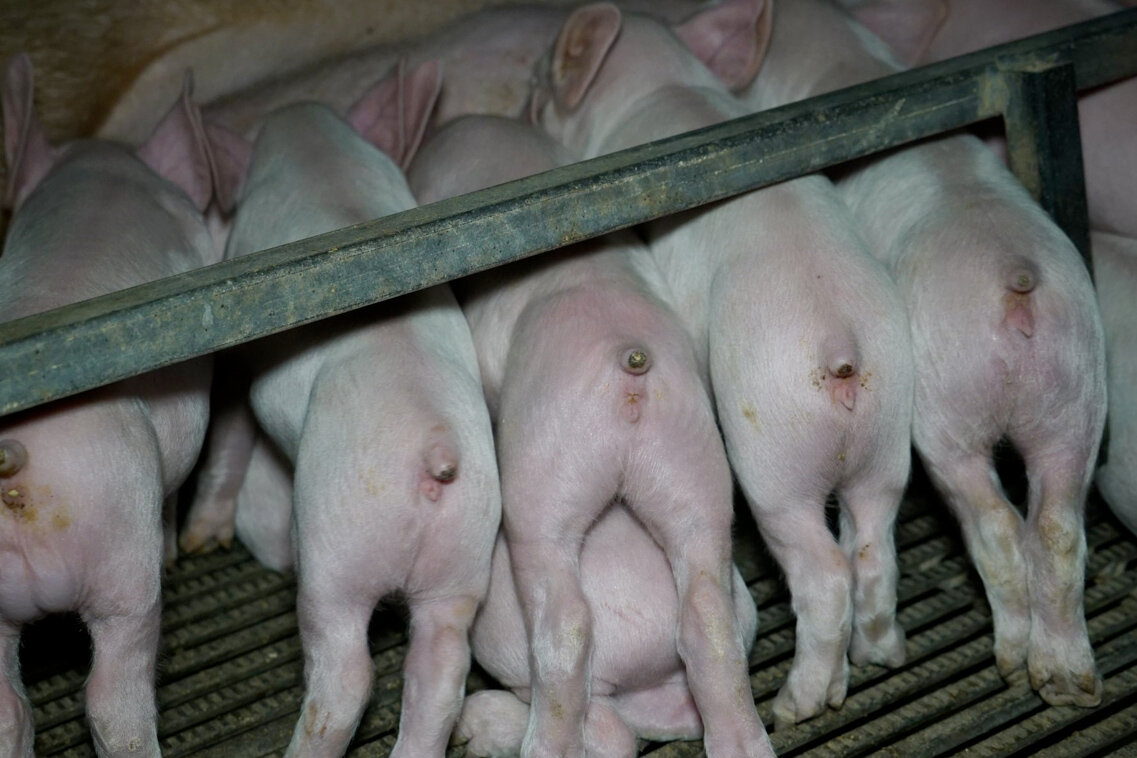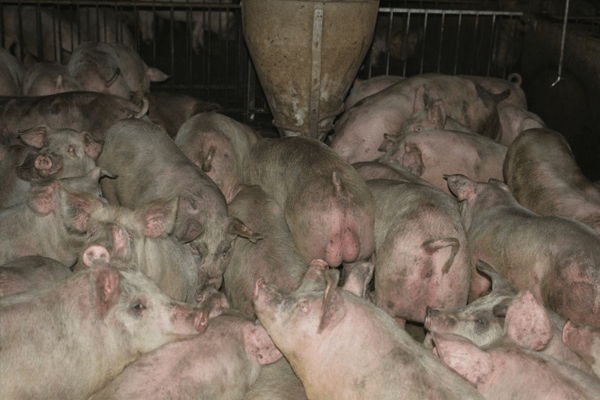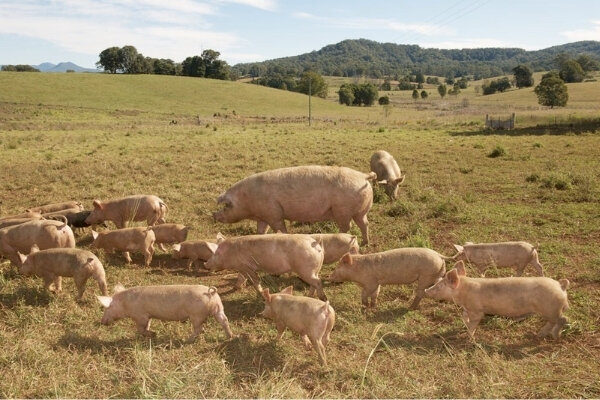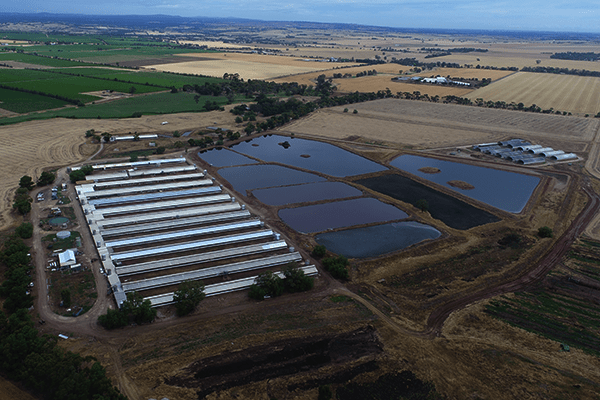
Pig Farming
Pigs are intelligent, friendly animals, who love to spend their days foraging and playing! Unfortunately, our desire to eat pork, ham, and bacon, has created a system where pigs are denied their natural behaviours and kept in appalling conditions. This choice has detrimental consequences for not only the well-being of the animals, but also the environment, our own health, and the health of others. This article explores these consequences, and looks at how we can change together to create a better world for all.
About Pigs
From intelligence to cleanliness, here are some facts that you may not know about pigs:
Pigs can perceive and estimate time passing
Pigs can sense the passing of time across days at a time. A study conducted on sows found that they were able to tell the passage of time by correctly choosing a high food reward every fifth day [1].
They are intelligent and have excellent memories
Pigs outperform dogs, some primates, and even 3-year-old children in some cognitive tasks. They have the ability to learn how to operate a joystick, understand the concept of mirrors, and are able to get a golf ball in a hole without picking it up. They also love a challenge and are persistent in solving problems on their own [2]. Pigs also have excellent memories, and can remember things and recognise objects for years.
Their high intelligence causes them to suffer greatly from boredom, due to a lack of stimulation in a confined environment. Spending their life trapped in a stall or pen, pigs exhibit abnormal behaviours like biting the tails of others, chewing on the metal cages, or aggression [3].
Pigs form strong friendships
A study conducted on a pig farm found that pigs form preferential associations or friendships with others [4]. They use grunts to communicate with each other and rub noses to bond [5]. Other studies found that a pig’s personality determines their grunts and showed that they “talk” to each other to convey important information, such as their emotional, motivational, and physiological state. An example of this is squealing when they feel fear, which can either be alerting others to their situation or offering assurance [6].
Sows are maternal
When a piglet is born, they follow their mother’s voice to her face and rub noses as a way of bonding. While the piglets nurse, the mother sings to them. Studies of piglet vocalisation showed that piglets grunts turned to screams when their mother moved away, and continued after being weaned and separated [7].
Julia and her piglets at Farm Sanctuary
Pigs are clean
Despite popular belief, pigs are one of the cleanest animals in the world. They refuse to excrete anywhere near their living or eating areas. Newborn piglets even leave the nest to go to the toilet within hours of birth [8]. Sadly, pigs on farms are forced to excrete where they live, making them incredibly distressed.
Pigs forced to live in each other’s waste.
Credit: Animal Liberation.
The Industry
Every year around the world, approximately 1.5 billion (1,500,000,000) pigs are killed for human consumption [9]. Australia accounts for approximately 5.5 million of them [10]. In almost all circumstances, pigs are killed at just 6-months old because it is not financially viable to keep them alive longer. If cared for, a pig can live for over 20 years! Despite knowing about the intelligence of pigs and their complex range of behaviours and needs, the industry purposefully ignores them to minimise costs and meet demands. For example, most pigs are kept confined in cramped conditions for the entirety of their lives, without any enrichment.
Their housing isn’t the only issue. Shortly after birth, piglets are “processed”, meaning they may undergo some surgical procedures often without any pain relief:
Standard Practices and Welfare Issues
Mating and artificial insemination
Although some farms use natural mating, more farms opt for artificial insemination. Artificial insemination involves collecting semen from boars and then artificially impregnating the female. This method is preferred, as farms reduce or eliminate the cost of keeping boars on-site and the risk of bringing in disease from external boars. It also allows the selection of the most preferred genetics [11].
Exposé by Animal Liberation and Animal Liberation QLD.
Ear Notching
For identification purposes, piglets may have their ears notched. The procedure involves using specialised pliers to punch a V-shaped notch or multiple notches on the outside of a piglet’s ear [12]. This procedure is performed without pain relief in their first 7-days of life [13 PDF]. Studies found that piglets who have their ears notched, displayed more grunting, vocalizations, head shaking, squeals, and escape attempts [14].
Credit: Animal Liberation & Farm Transparency Project
Tail docking
In intensive piggeries, piglets may have their tails docked, which involves cutting the tail (bones and muscles) off to prevent tail biting. This procedure can legally be performed without pain relief before they reach 7-days old [13].
Tail docking causes acute pain and possibly chronic pain if a neuroma forms. During the procedure, piglets scream, squeal, grunt, attempt to escape, struggle, wag their tail, or clamp it between their legs. Afterwards, piglets scoot on their bums and spend more time sitting down [14]. Docking their tails is completely unnecessary and can be prevented by providing them with adequate stimulation, bedding, and more room to move [15].
Castration
Male piglets are castrated to meet consumer requirements; if left uncastrated, their flesh develops an undesirable flavour and odour [16]. Castration can be performed without pain relief if the piglet is under 21-days old [13]. A newly castrated male is less active, and exhibits stiffness, trembling, and prostration. Many also rub and scratch their rump and wag their tail for four days. They also tend to isolate themselves [14].
Teeth Clipping
Piglets are born with canines, referred to as ‘needle’ teeth. Some farmers choose to cut off the tip of these teeth to prevent piglets from biting their siblings or mother’s udders [13].
Teeth clipping is incredibly painful for pigs. It can expose the cavity to infection, teeth may fracture and bleed, an abscess can form, and gums can be damaged. Piglets also display teeth champing and spend more time sleeping afterwards [14].
The footage below was released by Backpackers for Animals.
Killing by blunt force trauma
If a piglet, who is under 15kg, is injured or unwell, they can legally be killed with blunt force trauma. The most common method is for workers to slam the piglets head against the concrete floor [13]. If not performed correctly, the piglet will suffer excruciating pain and can be left to bleed out. It is also stressful for the mother, as she can see her baby be killed.
Feed
Grower pigs eat the equivalent of about 3% of their body weight and drink about 10% of their body weight each day. Pigs are omnivores and can be fed a combination of vegetables, grains, and meat. As a result, some pig farmers feed their pigs food waste – this has been found to include expired food, such as dairy products (including custard and ice cream), juice, confectionery, fish fillets, bread, or even ganache [17].
In addition to this, the animals who die before being sent to slaughter (particularly ducks and chickens) are collected and sent to a rendering plant where they are mixed with “waste” body parts of other animals – heads, blood, bone, hoofs, and feathers – that humans don’t consume. This mixture is then added to grains and vegetable proteins for other animals, such as pigs, ducks, chickens, fish, and turkeys, to eat [18 PDF].
Housing systems
Indoor
Indoor: Sow Stalls
In Australia, approximately 90% of pigs are kept in intensive, indoor farms. Within this housing system, sows can be kept in individual sow stalls, or housed in groups [19]. In sow stalls, sows are denied the ability to exhibit any natural behaviours. In nature, a pregnant sow would travel several kilometres to find an isolated spot, where she would build a nest to give birth [20 PDF]. On most farms, they live and sleep on concrete floors and are confined by metal bars that prevent them from turning around, only allowing one step forward or backward. A sow can stay here for up to 16 weeks [21]. In group housing, sows have more room to move, but can be aggressive towards one another due to the stress and lack of environmental enrichment. They are still forced to sleep on concrete and metal floors, living in their waste [22].
Typical sow stalls.
Credit: Farm Transparency Project.
Indoor: Boar Stalls
Boars, who are used for mating or semen collection, are also kept in isolated stalls. They are only let out for semen collection or mating, which may only be once a week. Last year, Animal Liberation NSW and QLD, exposed a boar semen collection facility in Queensland.
Indoor: Farrowing Crates
After the 16-weeks, sows are moved into farrowing crates to give birth, and they are kept there until her piglets are weaned – approximately 3-4 weeks later [21]. Very different from the nest pigs build in the wild, sows are forced to give birth on the cold metal and concrete floors. The mothers are once again confined by metal bars, only allowing small movements, and restricting their ability to tend to their babies. As with people, a sow’s muscles and bones deteriorate from a lack of use. As a result, these mothers spend most of their time laying down, unable to stand for long periods [21]. Workers occasionally hit the backs of the sows to force them to stand.
After her piglets are taken, the sow may be placed in a mating stall for up to 5 days – these are similar to sow stalls but used for artificial insemination. Then, she is returned to a sow stall or group housing [21].
A standard farrowing crate.
Credit: Farm Transparency Project.
Indoor: Grower Pens
After they have been weaned, piglets are moved into indoor group housing, where they will spend the next five months. In the indoor and outdoor pens, they cannot exhibit their natural behaviours, such as foraging, and as a result, they develop stereotypies (abnormal repetitive behaviours) [23].
Pigs in group housing.
Credit: Farm Transparency Project.
Outdoor Farms
Outdoor: raised indoors on straw
About 5% of sows are kept outdoors, meaning they have more room to move. After the sow’s babies have been weaned, they are moved into large barns with litter bedding [24], and she is impregnated again. The piglets spend the next 5 months confined to a barn with others. Apart from the litter bedding, there is no enrichment, and the pigs can become aggressive to each other.
Standard outdoor housing.
Animal Liberation
Free-Range
Free-Range
On a free-range farm, pigs have access to the outdoors. They are provided with housing for shelter and are not confined to stalls or farrowing crates [25]. Piglets are still weaned at 3-4 weeks old, and mothers are impregnated again. In pastures, the pigs may have a nose ring inserted to prevent them from foraging [13]. This, once again, purposefully denies them from exhibiting natural behaviours and is painful and distressing for the pigs.
After 3-5 years of repeated pregnancies, sows are slaughtered, as it is not economically viable to keep them alive.
Slaughter
Pigs from all systems end up in the same slaughterhouses. In Australia, there are three industry practices for stunning pigs before killing them. After stunning, pigs are stabbed in the throat and are left to bleed out.
Gas Chambers
According to the pig industry, carbon dioxide gas chambers are the most “humane” method to stun pigs before slaughter [26]. An undercover investigation in 2015 proved otherwise. When exposed to high concentrations of C02, pigs struggle violently until they pass out from asphyxiation. The percentage of CO2 used causes them to burn from the inside. Anonymous footage provided to Animal Liberation and Animal Liberation Victoria, shows pigs thrashing themselves around the cage, and they can be heard screaming.
Electrical and Captive-Bolt Stunning
Electrical stunning is used to render a pig unconscious, as it passes an electric current through their brain. This does not permanently damage their brain, meaning the pig may regain consciousness during the slaughter process if they aren’t quickly killed and bled out [27].
A captive-bolt gun can be either penetrating or non-penetrating. Both methods produce a physical shock to the brain, causing irreversible damage if done correctly [27].
Captive bolt stunning at Gretna Slaughterhouse.
Full exposé by Animal Liberation.
The Environment
Australia has roughly 2,700 pig producers – 90% of which are intensive commercial indoor facilities [28]. As a result, pig farms do not require as much land as cattle and sheep. Nevertheless, they still require land to be cleared for the sheds and feed, are extremely water-intensive, and are polluting the surrounding environment.
Aerial shot of a pig farm.
Farm Transparency Project Map.
Resources
Pig farming requires water for drinking, feed, cleaning, and during the slaughter process [29]. According to Australian Pork, the world average is approximately 4,856 litres of water used per kilogram of pigmeat, while conventional Australian systems use around 3,020 litres per kilogram [30].
Waste and emissions
A pig produces four times more waste than a human being, meaning a large pig farm can easily create the same amount of waste as a small city [31]. Their waste contains high concentrations of nutrients (nitrogen, potassium, and phosphorus), and trace contaminants (heavy metals, organic compounds, and endocrine-disrupting chemicals) [32].
Some traditional farming systems use their manure to grow crops. The amount of manure, however, generally exceeds the land’s ability to absorb it, so waste is stored in lagoons or pits. These pits have been known to break or leak, contaminating surrounding water sources. Spraying the waste also contaminates water, soil, and air [33].
Waste ponds at an intensive pig farm.
Farm Transparency Project.
Health Impacts
Your Health
Despite popular belief, pork is classified as red meat. According to a Harvard study, eating red meat contributes to premature death. The study found that eating an additional daily serving of red meat increased the risk of death by 13%, and up to 20% if the serving was processed [34]. A review of various studies found that the consumption of red meat was related to “major chronic diseases, such as diabetes, coronary heart disease, heart failure, stroke and cancer (colorectal, pancreatic, breast, and prostate), and mortality” [35].
In 2015, the World Health Organisation classified red meat as a Group 2A, meaning it is likely carcinogenic to humans [36]. This was based on the research finding a link between colorectal, pancreatic, and prostate cancer, and the consumption of red meat. Although more research needs to be done, the study estimates “that the risk of colorectal cancer could increase by 17% for every 100-gram portion of red meat eaten daily” [37].
The World Health Organisation listed processed meat as a Group 1 carcinogen, meaning that there is convincing evidence that it causes cancer, and more specifically, colorectal cancer. This places it in the same category as tobacco smoking and asbestos [38]. Cured, preserved, and processed products, like bacon, ham, prosciutto, salami, pancetta, and sausages, contain high amounts of sodium, nitrates, and nitrites. High amounts of sodium are linked to hypertension (high blood pressure, increased risk of cardiovascular disease (a stroke or coronary artery disease), and weight gain. Nitrates and nitrites can cause methemoglobinemia, where your red blood cells aren’t able to transport oxygen through your body. They can also be broken down and become carcinogenic, increasing the risk of some cancers [39].
To learn more about the impacts of red meat on your health, visit the health section in our Cattle Farming issues page.
Please note that we are not nutritionists. If you would like nutrition-specific advice, please reach out to us and we can find someone in your area.
Dana Hunnes, PhD, Dietitian, and Adjunct Professor at UCLA Fielding-School of Public Health.
Workers and nearby residents
Workers and people who live near pig farms are at risk of illnesses due to exposure to pig waste. Pig manure contains elements, such as heavy metals, pathogenic bacteria, and also emit volatile gases, which are a concern for human health. Several studies have found adverse physical and mental health effects on workers and people in surrounding communities from the ammonia and hydrogen sulphide. Communities located within 2km from pig farms can be exposed to “ammonia levels up to 40 times greater than average ambient concentrations” [40]. People have frequently reported that they suffer from “eye, nose, and throat irritations, headaches, nausea, diarrhoea, cough, chest tightness, palpitations, shortness of breath, stress, drowsiness” [41]. Another study in the United States found people living within close proximity to pig farms had increased levels of tension, depression, anger, fatigue, and confusion. In some, it also triggered an increase in heart rate and blood pressure [42].
Slaughterhouse workers
While we comfortably buy packaged animal products, most of us would not be physically or emotionally capable of taking an animal’s life and butchering it for meat. This has created an ethical conundrum, as we force someone to do it for us. It isn’t hard to imagine that most slaughterhouse workers do not want to do the killing either. Many often end up in this role due to geography, level of education, or limitation of employment opportunities in the area. These individuals need to make a living – to be able to financially support themselves and their families. This leads to taking a job with the requirement of killing thousands of animals a week. This requirement can have a profound psychological effect on the workers.
Studies have found a correlation between slaughterhouse work and post-traumatic stress disorder [43], cognitive dissonance, and perpetration-induced traumatic stress [44]. These can lead to anxiety, panic, depression, drug and alcohol abuse, increased paranoia, a sense of disintegration, dissociation, and amnesia. International studies have found a link between working in a slaughterhouse and an increase in crime rates, from domestic and child abuse. They are also linked to drug and alcohol abuse [45 PDF, 46]. Research by Dr Nik Taylor at Flinders University found that slaughterhouse workers are more inclined to commit acts of violence. The study showed that meatworkers were more physically aggressive, angry, and hostile than farmers [47].
“The worst thing, worse than the physical danger, is the emotional toll… Pigs down on the kill floor have come up and nuzzled me like a puppy. Two minutes later I had to kill them—beat them to death with a pipe. I can’t care.”
Ed Van Winkle, hog-sticker at Morrell slaughterhouse plant, Sioux City, Iowa
Slaughterhouse workers are also subjected to injuries, due to the dangerous work environment [48]. For up to 14 hours a day, workers are handling sharp blades and hooks, boiling water, and animals who are fighting for their lives. Common injuries include musculoskeletal injuries caused by rapid repetitive motions (such as tendonitis, carpal tunnel syndrome, and white finger), loss of fingers and limbs [49], or even death [50].
Pigs in holding pen at a slaughterhouse.
Credit: Anonymous
What’s Next?
There is a lot of information to take in, much of it very grim and shocking, so we would like to thank you again for choosing to learn about the impacts of animal agriculture. Developing our understanding of the animals, the industry, and the environmental and personal impacts is an enormous aspect of facilitating change.
Pigs deserve so much more than to be cramped into stalls and pens, mutilated, and killed, and we owe it to the animals, people, and planet to seek out alternatives.
If you’re still thinking, but I really enjoy my bacon on a Sunday morning, we’ve got you covered! We’ve put together a huge list of plant-based alternatives, covering ham and bacon through to pulled pork and roasts. Excitingly, new products are continuously cropping up in stores and supermarkets everywhere, so this journey will only get easier.
















